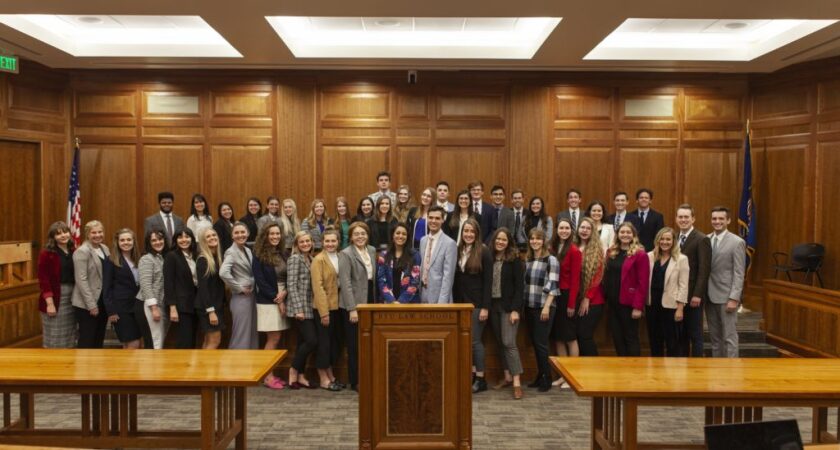
The current BYU Model United Nations Team gather for a group photo (Cory Leonard)
The BYU Model United Nations team recently returned home after competing at the National Model United Nations conference in New York City on March 24-28. The team won an outstanding delegation award for Italy, one of the team's two represented countries, putting it in the top 1% of attending schools. The team also received an honorable mention award for Turkmenistan, placing it in the top 10%.
Additionally, 12 students won outstanding partnership awards for their diplomacy work. Three other pairs received position paper awards.
According to the David M. Kennedy Center for International Studies website, Model United Nations is a class offered at BYU that allows students to gain skills in diplomacy through lectures, assignments and international negotiation simulations.
The National Model United Nations is the world’s oldest and largest intercollegiate Model United Nations conference. More than 5,000 university students from around the world attend the conference each year. According to the Model United Nations website, more than half of the conference’s participants come from outside of the United States.
BYU's Model United Nations team has 45 students who prepared for a semester in a class students are required to complete before competing. The team represents different countries each year. The team represented Italy and Turkmenistan this year.
Aidan Houston is a junior studying European studies and Russian. He said his favorite part about the conference was standing in the historic General Assembly Hall located in the United Nations Headquarters by New York City's East River.
“You walk into this place where some of the most important decisions in human history have been made,” Houston said. 'There's the podium. You're like, feet away from the podium where Nikita Khrushchev banged his shoe on the podium and John F. Kennedy made his speeches.”
Houston said he was looking to be a part of something fun as a recent transfer from another university and happened upon the Model United Nations team. He said he went to a meeting and liked it, but when he went to New York to compete for the first time, he was hooked.
Houston said BYU can be homogeneous, but participating in the Model United Nations team has helped him learn how to work with people who have a variety of opinions and backgrounds.
Students participate in eight four-hour sessions over the course of four days where they are split into different committees and do a variety of activities, like make motions and speeches. The competition is meant to reflect how an actual United Nations session operates.
Houston said each session is then broken up into periods of informal caucusing where students can move freely to talk to other delegations. During this, he said, they try to find people with like-minded ideas and create coalitions.
Houston said a large part of the competition is writing a resolution, which is essentially the solution to the problem being discussed throughout the conference. This is then presented to the body and voted on.
Houston represented Turkmenistan this year.
“I think it's like give and take, like in the real world. Sometimes you do just have to stick to what you believe in. Other times, you have to try to open your mind and consider new perspectives,” Houston said.
Cory Leonard, associate director of the Kennedy Center, said BYU's Model United Nations team is an experiential learning diplomacy simulation.
“You learn about leadership, about global issues, and you develop skills by simulating diplomacy,” Leonard said.
Leonard said he often compares the team to an internship because students are doing the same types of things in the classroom and at the conference that they would at an internship.
Leonard said the team draws in students who are studying international relations and political science, but also those of other majors and disciplines.
“Fifty percent of the people on our model UN program are social science majors, but the other 50% are advertising majors, English majors, engineering majors, genetics and neuroscience and social science,” Leonard said.
The team spent the semester learning the foreign policies of Italy and Turkmenistan. To represent the countries and make decisions in the way those countries' leaders would, Leonard said the students spent a great deal of time learning to authentically portray the countries.

The Model United Nations Women Committee pose with their country signs they represent during the conference (Cory Leonard)
Reagan Curtis, a junior studying political science, said she joined the team because she had friends who were obsessed with it, but stayed because of the students she got to interact with. Curtis said she loves competing and interacting with students from all over the world who share her passions.
She said she was the only native English speaker in the group she was assigned to at the completion.
“It's cool because you are representing a country that maybe, necessarily, you don't agree with their stance on things. For example, I was Turkmenistan,” Curtis said. “You have to kind of personify that nation.”
Curtis said her favorite part of competing in New York was interacting with a whole spectrum of other students.
“It was really cool to see so many different minds, from so many different places, all focused on the same issue,” Curtis said.